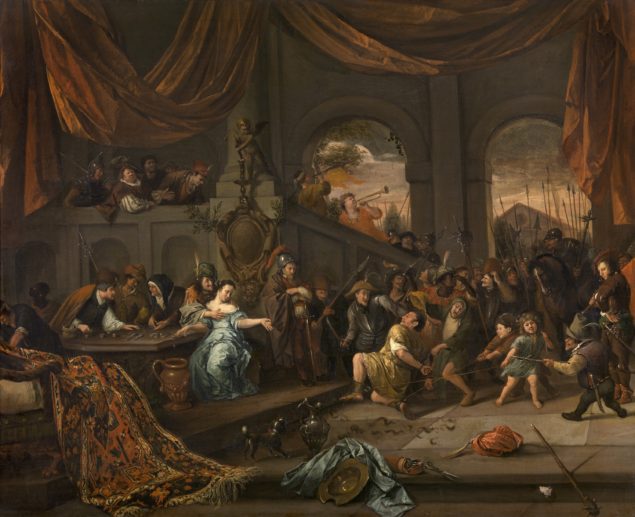The Mocking of Samson, a painting in the collection of the Royal Museum of Fine Arts Antwerp (KMSKA), has been reattributed to Jan Steen. After extensive research, specialists from the Mauritshuis have concluded that the painting — long thought to have been an eighteenth-century copy after Jan Steen – is by the master himself. Its style of painting, technique and subject matter are entirely in keeping with Steen’s oeuvre. The painting has undergone technical examination at the Mauritshuis in collaboration with Shell and conservation treatment by conservators from the museum. The newly restored and rediscovered Steen from Antwerp will feature as one of the highlights of the upcoming exhibition Jan Steen’s Histories, on at the Mauritshuis from 15 February.

Jan Steen (ca. 1625-1679), The Mocking of Samson, ca.1675-1676
Royal Museum of Fine Arts Antwerp, Antwerp
Information from the Mauritshuis, 9 February 2018
Emilie Gordenker, director of the Mauritshuis: ‘During the process of selecting the loans for the Jan Steen’s Histories exhibition, our curator Ariane van Suchtelen had a strong suspicion that The Mocking of Samson was not a copy, but had actually been painted by Jan Steen himself. After further research, restoration and technical examination we have come to the conclusion that not only is this painting by the master himself, but that it is still in excellent condition. It’s as if the canvas is fresh out of Jan Steen’s studio – thrilling!’

Unusual is the fact that the canvas is still attached to its original strainer, with original nails (photographer: Ivo Hoekstra, Mauritshuis, The Hague)
Director in chief and chief conservationist Manfred Sellink of the Royal Museum of Fine Arts in Antwerp: ‘KMSKA is closed for extensive renovation work and we have used this opportunity to send our artworks as ambassadors to foreign museums for display. Our long-term cooperation with the Mauritshuis has resulted in exhibitions such as Neighbours: Portraits from Flanders and presentations such as Antonello at the Gallery. Flemish masters from the KMSKA’s collection are set against masterpieces from the Mauritshuis Museum’s permanent display. Both institutions benefit greatly from the exchange of expertise. The restoration of this painting, leading to its attribution to Jan Steen, is a wonderful result of this special partnership. Thanks to the Mauritshuis, KMSKA has been enriched by a genuine Jan Steen.’
Jan Steen research project
Since 2012 the Mauritshuis and Shell have been working together as Partners in Science on an innovative technical research project into the materials used by Jan Steen (1626-1679), with the aim of gaining a better insight into the chronology of his work. The chronology of his oeuvre is difficult to determine as only one in ten of his works is dated. To date, 37 works by Jan Steen (from the Mauritshuis and from other collections) have been examined, representing the entire span of his career. All the paintings have been examined using a range of advanced techniques. In the Shell Technology Centre in Amsterdam pigment samples are analysed using SEM-EDX, a scanning electron microscope with energy dispersing X-rays. This enables researchers to ascertain the chemical elements contained in the pigments and in which concentrations they are present.
In a large number of the works by Jan Steen researchers detected green earth pigment, a relatively bright type of green earth that was not very prevalent in the seventeenth century. The paintings in which this pigment is found all appear to date from Steen’s late period. This green earth pigment was also found in The Mocking of Samson, where it occurs in the sash of the standard-bearer depicted on the right of the painting. This detail, together with data on the ground layers, groups the painting with works executed by Steen in the 1670s. This was near to the end of his life, when the artist had returned to his birthplace Leiden. This type of research is helping us to discover more about Steen’s use of materials and the chronology of his oeuvre.
